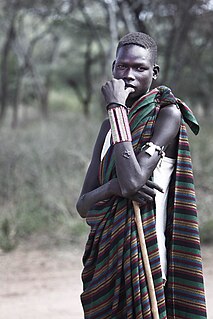Coordinates: 4°46′22″N33°35′03″E / 4.772644°N 33.584132°E The Singaita River (also Khawr Thingaita, Khor Thingaita, Rigl Thimgaita, Singeitta) is a river in Eastern Equatoria state of South Sudan that flows through the town of Kapoeta.

A geographic coordinate system is a coordinate system that enables every location on Earth to be specified by a set of numbers, letters or symbols. The coordinates are often chosen such that one of the numbers represents a vertical position and two or three of the numbers represent a horizontal position; alternatively, a geographic position may be expressed in a combined three-dimensional Cartesian vector. A common choice of coordinates is latitude, longitude and elevation. To specify a location on a plane requires a map projection.

Eastern Equatoria is one of the ten states of South Sudan. It has an area of 73,472 km². The capital is Torit.

South Sudan, officially known as the Republic of South Sudan, is a landlocked country in East-Central Africa. The country gained its independence from the Republic of the Sudan in 2011, making it the newest country with widespread recognition. Its capital and largest city is Juba.
The Nathilani River, which starts from Nathilan hills in Loudo and flows through Loudo, is one of the Singaita's tributaries. The Murle people at one time lived in the Thingaita Valley, but were later displaced by the Toposa. [1] The Toposa people now live along both sides of the Singaita and Lokalyen rivers. [2]
The Murle are a Nilotic ethnic group inhabiting the Pibor County and Boma area in Jonglei State, South Sudan, as well as parts of southwestern Ethiopia. They have also been referred as Beir by the Dinka and as Jebe by the Luo and Nuer, among others. The Murle speak the Murle language, which is part of the Surmic branch of the Nilo-Saharan family. The language cluster includes some adjoining groups in Sudan, as well as some non-contiguous Nilotic populations in southwestern Ethiopia.

The Toposa are an ethnic group in South Sudan, living in the Greater Kapoeta region of the erstwhile Eastern Equatoria state. They have traditionally lived by herding cattle, sheep and goats, and in the past were involved in the ivory trade. They have a tradition of constant low-level warfare, usually cattle raids, against their neighbors.
The post at Kapoeta on the east bank of the river was established by Captain Knollys, who reached the river in January 1927. [3] Near Kapoeta the river is about 150 yards wide, and normally has a sandy dry bed, but heavy rainstorms in the Didinga Hills can turn it into a raging, impassable flood overnight. [4] A 125-meter drift was built to cross the Thingaita River at Kapoeta with USAID funding in 1983. [5]

The Didinga Hills are an upland area in Namorunyang State of South Sudan, lying mainly within Budi County. Before the reorganisation of states, it was an part of Eastern Equatoria. They are named for the Didinga people who live in the region. The Didinga Hills have rich and fertile soil that is used for cultivation of tobacco, potatoes, maize, and Dura.



